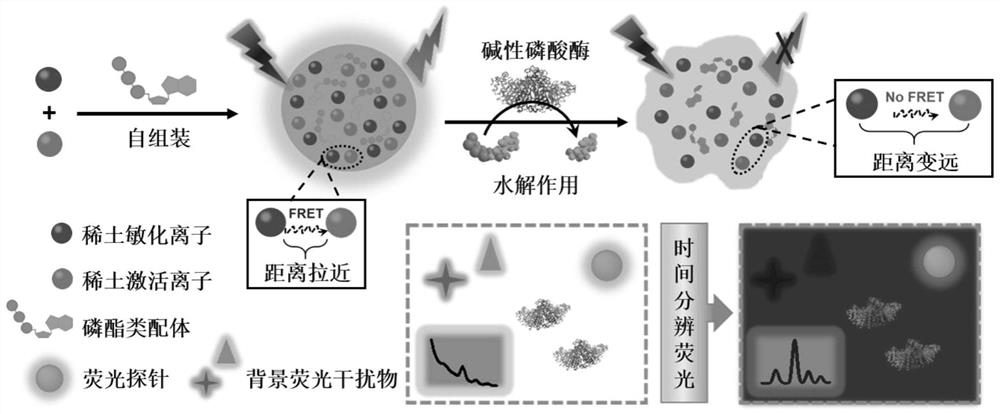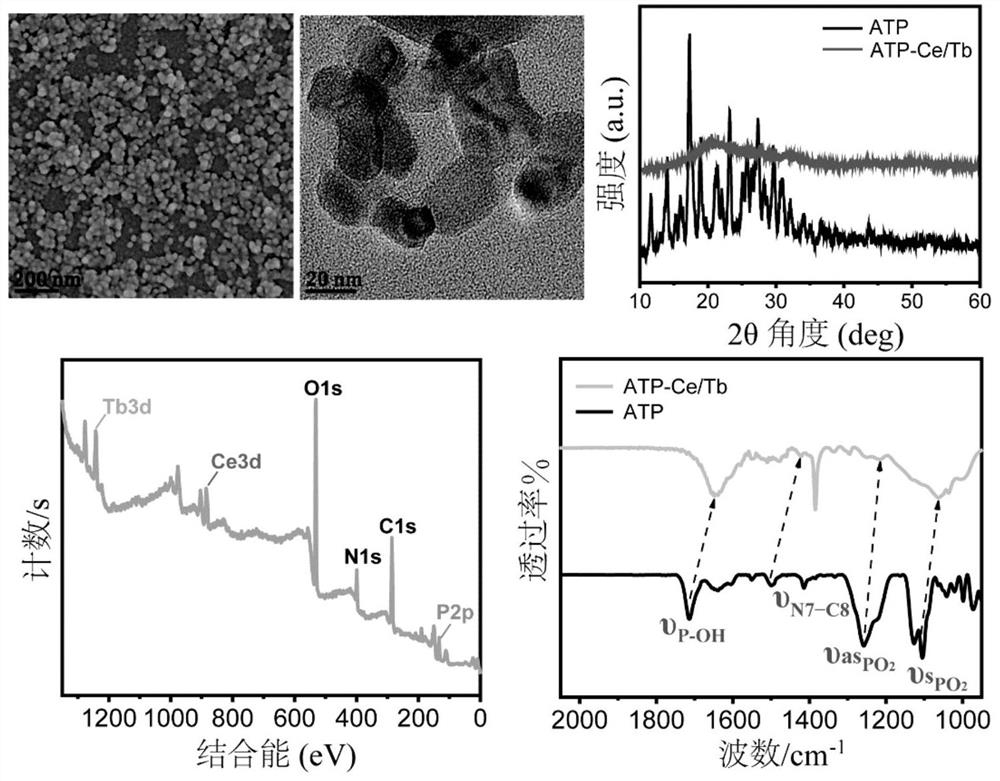Enzyme response type probe based on rare earth metal and preparation method and application thereof
A kind of rare earth metal, rare earth metal salt technology
- Summary
- Abstract
- Description
- Claims
- Application Information
AI Technical Summary
Problems solved by technology
Method used
Image
Examples
preparation example 1
[0046] Preparation Example 1: Synthesis of Rare Earth Metal-Based Enzyme-Responsive Probes (Dual Ion Probes)
[0047] The probe is prepared by stirring at room temperature, using rare earth nitrates and ATP compounds as raw materials, and the preparation method is as follows:
[0048] (1) Weigh the same amount of Ce(NO 3 ) 3 ·6H 2 O, Tb(NO 3 ) 3 ·6H 2 O is dissolved in the Tris-HCl aqueous solution of pH=9.0, is prepared into the rare earth ion solution that the total concentration of rare earth ion is 4mM;
[0049] (2) ATP was weighed and dissolved in Tris-HCl aqueous solution to prepare an ATP solution with a concentration of 2mM;
[0050] (3) Take 1 mL of the rare earth ion solution in step (1) and mix evenly, add dropwise to 1 mL of the ATP solution in step (2), and stir at room temperature for one minute.
[0051] The characterization results of the prepared probes (also known as dual ion probes) are shown in figure 2 , wherein, (a), (b) are transmission electron...
Embodiment 1
[0064] Embodiment 1: the detection of alkaline phosphatase concentration
[0065] (1) Using a polystyrene 96-well plate as the carrier used for detection, add 100 μL of the probe solution prepared in Preparation Example 1 in 7 rows in sequence to the set microwells, and the concentrations in each row are 32, 16, 8, 4, 2, 1, 0.5mM, add 100μL alkaline phosphatase (ALP) aqueous solution with different concentrations in each column in turn, the concentrations are 3000, 2500, 2000, 1500, 1250, 1000, 750, 500, 250, 125, 62.50, 31.25, 15.63, 7.81, 0U / L; place at 37°C for 3 hours and shake at a constant temperature, measure the fluorescence intensity of the mixed solutions in 7 rows and 15 columns, and calculate the fluorescence quenching efficiency of each group of mixed solutions; when the fluorescence quenching efficiency is the largest The probe concentration corresponding to the mixed solution is 4mM, and the concentration of alkaline phosphatase in the mixed solution is used for...
Embodiment 2
[0068] Example 2: The detection specificity verification of alkaline phosphatase to be tested
[0069] (1) The reagents, instruments, and probes required for the experiment are all consistent with those in Example 1.
[0070] (2) Common interfering substances in the blood were selected for the experiment: arginine, glycine, biotin, citric acid, lactose, bovine serum albumin (BSA), glucose oxidase (GOD), cholinesterase, metal ions (K + , Ca 2+ , Cl - 、Na + , Mg 2+ ).
[0071] (3) After grouping the detection well plate in the 96-well plate, add 100 μL of the above-mentioned interfering substance aqueous solution with a concentration of 100 mg / mL and 100 μL of an alkaline phosphatase aqueous solution with a concentration of 100 U / L to 100 μL containing the probe ( In the Tris-HCl buffer solution with a final concentration of 4 mM) at pH = 9.0, the 96-well plate was placed at 37°C for a constant temperature shaking reaction for 3 hours, and the reacted 96-well plate was plac...
PUM
 Login to View More
Login to View More Abstract
Description
Claims
Application Information
 Login to View More
Login to View More - R&D
- Intellectual Property
- Life Sciences
- Materials
- Tech Scout
- Unparalleled Data Quality
- Higher Quality Content
- 60% Fewer Hallucinations
Browse by: Latest US Patents, China's latest patents, Technical Efficacy Thesaurus, Application Domain, Technology Topic, Popular Technical Reports.
© 2025 PatSnap. All rights reserved.Legal|Privacy policy|Modern Slavery Act Transparency Statement|Sitemap|About US| Contact US: help@patsnap.com



